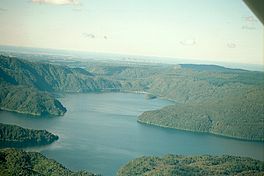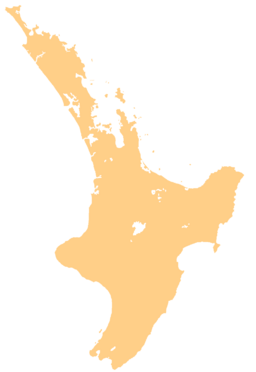Lake Ōkataina facts for kids
Quick facts for kids Lake Ōkataina |
|
|---|---|

Aerial view from the south
|
|
| Location | Bay of Plenty, North Island |
| Coordinates | 38°07′S 176°25′E / 38.117°S 176.417°E |
| Type | crater lake |
| Native name | Te Moana i kataina ā Te Rangitakaroro Error {{native name checker}}: parameter value is malformed (help) |
| Basin countries | New Zealand |
| Max. length | 6.2 km (3.9 mi) |
| Max. width | 5.0 km (3.1 mi) |
| Surface area | 10.8 km2 (4.2 sq mi) |
| Average depth | 44.0 m (144.4 ft) |
| Max. depth | 78.5 m (258 ft) |
| Surface elevation | 311 m (1,020 ft) |
Lake Ōkataina, also known as Te Moana i kataina ā Te Rangitakaroro, is a beautiful lake in New Zealand. It is the biggest and most northern of four smaller lakes. These lakes are found between Lake Rotorua and Lake Tarawera in the Bay of Plenty region. The other lakes nearby are Lake Rotokakahi (which is also called Green Lake), Lake Tikitapu (known as Blue Lake), and Lake Ōkareka. All these lakes are located inside a large volcanic area called the Okataina caldera.
Contents
Discover Lake Ōkataina
Lake Ōkataina is located on the North Island of New Zealand. It is part of a group of lakes formed by volcanic activity. This lake is special because it is completely surrounded by native forest. This means you will see lots of natural trees and plants around its edges.
What Makes Lake Ōkataina Unique?
Unlike many other lakes in the area, Lake Ōkataina does not have any rivers flowing into it or out of it. This makes it quite unusual! Because of this, the lake's water level has changed a lot over the last 30 years. It has risen and fallen by about 5 meters. This can make a big difference to the shoreline.
The Meaning of the Name
The name Ōkataina has a special meaning. The New Zealand Ministry for Culture and Heritage says that Ōkataina means "place of laughter." This name comes from the Māori language.
Visiting Lake Ōkataina
You can get to Lake Ōkataina by driving on a road from Hinehopu. Hinehopu is on the southern side of Lake Rotoiti. At the end of the road, you will find a large sandy beach. There is also a big grassy area perfect for relaxing. You will also see the Okataina Lodge, which is a privately owned place to stay. Because the lake's water level changes, the lodge's boat jetty has sometimes been underwater or left far from the water.
Wildlife Around the Lake
The area around the lodge is home to many tammar wallabies. These animals look a bit like small kangaroos. They were brought to New Zealand from Australia in the 1800s. You might spot them hopping around if you visit!


